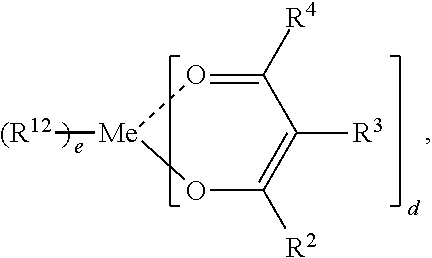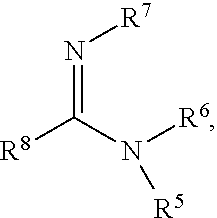Curable organopolysiloxane compositions
a polyorganosiloxane composition and composition technology, applied in the field of curable organopolysiloxane compositions, can solve the problems of short working time, short potlife, and difficulty in further processing of prematurely crosslinked polyorganosiloxane compositions, and achieve rapid curing of mixtures and low catalytic
- Summary
- Abstract
- Description
- Claims
- Application Information
AI Technical Summary
Benefits of technology
Problems solved by technology
Method used
Image
Examples
example b1
[0276]For a gel time measurement, 0.04 g of 1,1,3,3-tetramethylguanidine (“TMG”; CAS No. 80-70-6; available commercially from Sigma-Aldrich®, Steinheim, DE) was diluted in 0.04 g of (2,4,4-trimethylpentyl)trimethoxysilane (CAS No. 88468-45-5; available commercially from Sigma-Aldrich®, Steinheim, DE) and this solution was subsequently added to a mixture of 0.092 g of zinc(II) acetylacetonate (“Zn(acac)2”, CAS No. 14024-63-6, available commercially e.g. from Merck KGaA, Darmstadt, DE) in 0.048 g of absolute ethanol (available commercially from Sigma-Aldrich®, Steinheim, DE); the mixture was stirred intimately with heating to 45° C. until a solution was formed. The catalyst solution was then mixed with 10 g of the resin mixture A1 in a Speedmixer™ DAC 150 FVZ from Hauschild & Co. KG for 30 seconds at 2000 r·min−1, and lastly the mixture was transferred to a test tube for determination of gel time. The results are found in table 1.
example b2
[0277]Example B1 was repeated, with the difference that instead of a mixture of 0.092 g of Zn(acac)2 in 0.048 g of absolute ethanol, a mixture of 0.061 g of zinc(II) 2-ethylhexanoate (CAS No. 136-53-8; available commercially from ABCR, Karlsruhe, DE) in 0.024 g of absolute ethanol was used, and mixing took place at 23° C.
[0278]The results are found in table 1.
example b3
[0279]Example B1 was repeated, with the difference that instead of a solution of 0.04 g of 1,1,3,3-tetramethylguanidine in 0.04 g of (2,4,4-trimethylpentyl)trimethoxysilane, 0.043 g of 1,5-diazabicyclo[4.3.0]non-5-ene (“DBN”, CAS No. 3001-72-7, available commercially from Sigma-Aldrich®, Steinheim, DE) and, instead of a mixture of 0.092 g of Zn(acac)2 in 0.048 g of absolute ethanol, a mixture of 0.092 g of Zn(acac)2 in 0.138 g of absolute methanol (available commercially from Sigma-Aldrich®, Steinheim, DE) were used.
[0280]The results are found in table 1.
PUM
| Property | Measurement | Unit |
|---|---|---|
| Percent by mass | aaaaa | aaaaa |
| Fraction | aaaaa | aaaaa |
| Substance count | aaaaa | aaaaa |
Abstract
Description
Claims
Application Information
 Login to View More
Login to View More - R&D
- Intellectual Property
- Life Sciences
- Materials
- Tech Scout
- Unparalleled Data Quality
- Higher Quality Content
- 60% Fewer Hallucinations
Browse by: Latest US Patents, China's latest patents, Technical Efficacy Thesaurus, Application Domain, Technology Topic, Popular Technical Reports.
© 2025 PatSnap. All rights reserved.Legal|Privacy policy|Modern Slavery Act Transparency Statement|Sitemap|About US| Contact US: help@patsnap.com



